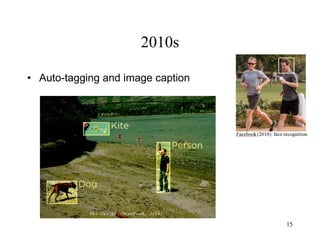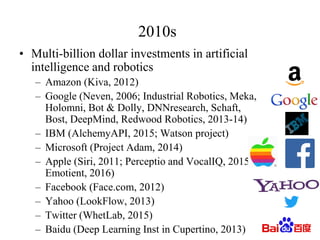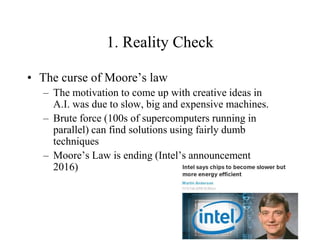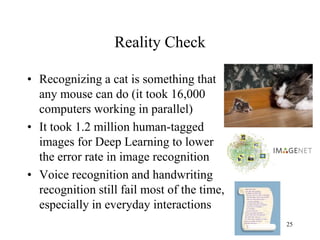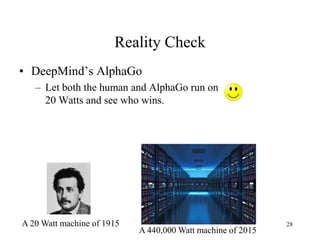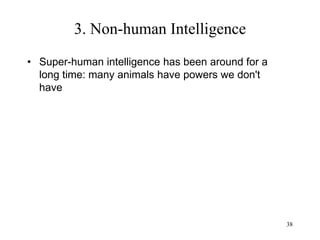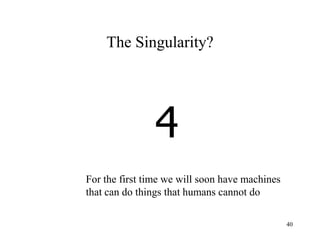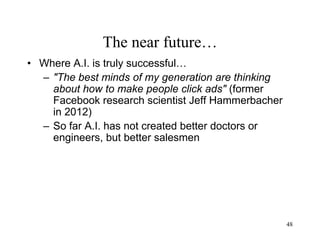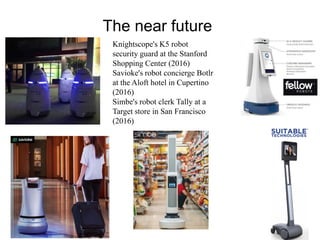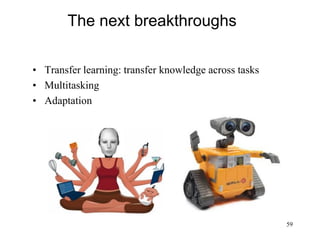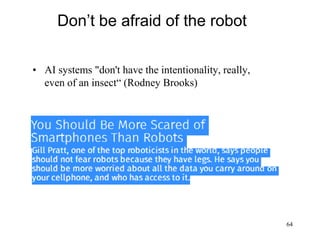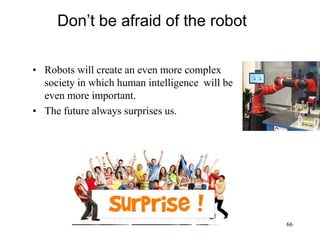Intelligence is not Artificial - Stanford, June 2016
- 1. Intelligence is not Artificial piero scaruffi www.scaruffi.com April 2016 "The person who says it cannot be done should not interrupt the person doing it" (Chinese proverb)
- 2. Piero Scaruffi • piero scaruffi p@scaruffi.com www.scaruffi.com Olivetti AI Center, 1987
- 3. 3 What I am going to tell you Journalist: Are you afraid of A.I.? Piero: I am afraid that it will not come soon enough!
- 4. Table of Contents 1. From the electronic brain to AlphaGo 2. Why the Singularity is not coming any time soon 3. The near Future of A.I. 4
- 5. 55 Electronic Brains 1946: The first non-military computer, ENIAC, or "Electronic Numerical Integrator and Computer", is unveiled, built by John Mauchly and Presper Eckert at the University of Pennsylvania
- 8. In the beginning… Artificial Intelligence (1956) • Knowledge-based approach uses mathematical logic to simulate human intelligence • Neural-net approach simulates the structure of the brain 8
- 9. 9 The #1 factor: Moore’s Law The future of your brain is coming faste than your brain can think…
- 10. The Age of Deep Learning 1997: Sepp Hochreiter's LSTM 1998: Yann LeCun 's second generation Convolutional Neural Networks 2006: Geoffrey Hinton’s Geoffrey Hinton's Deep Belief Networks 2007: Yeshua Bengio's Stacked Auto- Encoders Deep Learning
- 11. The Age of Deep Learning Hava Siegelmann: Israel Sepp Hochreiter‘: Germany Yann LeCun: France Geoffrey Hinton: Britain Yeshua Bengio: France Andrew Ng: China
- 12. 12 2010s • Google (2012): 1.7 billion connections (and 16,000 processors) learn to recognize cats in YouTube videos 12
- 13. 13 2010s • The personal assistant – Apple Siri (2011) – GoogleNow (2012) – Microsoft Tay (2016) – … Apple 2011 Stanley Kubrick (1968) “2001: A Space Odyssey” (mandatory Hollywood movie for AI presentation) Microsoft,2016
- 15. 15 2010s • Auto-tagging and image caption 15
- 16. 16 2010s 2015: Microsoft’s 152-layer neural network
- 17. 17 2010s • Multi-billion dollar investments in artificial intelligence and robotics – Amazon (Kiva, 2012) – Google (Neven, 2006; Industrial Robotics, Meka, Holomni, Bot & Dolly, DNNresearch, Schaft, Bost, DeepMind, Redwood Robotics, 2013-14) – IBM (AlchemyAPI, 2015; Watson project) – Microsoft (Project Adam, 2014) – Apple (Siri, 2011; Perceptio and VocalIQ, 2015; Emotient, 2016) – Facebook (Face.com, 2012) – Yahoo (LookFlow, 2013) – Twitter (WhetLab, 2015) – Baidu (Deep Learning Inst in Cupertino, 2013) 17
- 18. 18 2010s • DeepMind (2010): machine learning (acquired by Google in 2014) • Vicarious: machine learning • Sentient: machine learning • Wise.io • Saffron • Narrative Science • … 18
- 19. 19 2010s • Computer Go/Weichi – 2009: Fuego Go (Monte Carlo program by Univ. of Alberta) beats Zhou Junxun – 2010: MogoTW (Monte Carlo program developed in 2008 by a Euro-Taiwanese team) beat Catalin Taranu – 2012: Tencho no Igo/ Zen (Monte Carlo program developed by Yoji Ojima in 2005) beat Takemiya Masaki – 2013: Crazy Stone (Monte Carlo program by Remi Coulom in 2005) beat Yoshio Ishida – Pachi (open-source Monte Carlo program by Petr Baudis)
- 20. 20 2010s 2016: Google/DeepMind’s AlphaGo beats the weichi champion Se-dol Lee
- 21. 21 Robots
- 22. 22 The Singularity? The four assumptions of the Singularity movement 1. Artificial Intelligence systems are producing mindboggling results 2. Progress is accelerating like never before 3. For the first time we will have to deal with super-human intelligence 4. For the first time we will have machines that can do things that humans cannot do 22
- 23. 23 The Singularity? 1 Artificial Intelligence systems are producing mindboggling results
- 24. 24 1. Reality Check • The curse of Moore’s law – The motivation to come up with creative ideas in A.I. was due to slow, big and expensive machines. – Brute force (100s of supercomputers running in parallel) can find solutions using fairly dumb techniques – Moore’s Law is ending (Intel’s announcement 2016)
- 25. 25 Reality Check • Recognizing a cat is something that any mouse can do (it took 16,000 computers working in parallel) • It took 1.2 million human-tagged images for Deep Learning to lower the error rate in image recognition • Voice recognition and handwriting recognition still fail most of the time, especially in everyday interactions
- 26. 26 Reality Check • DeepMind’s AlphaGo – Supervised learning – Large dataset of 150,000 games – Monte Carlo tree search – Reinforcement learning (playing against itself)
- 27. 27 Reality Check • DeepMind’s AlphaGo – What else can AlphaGo do besides playing Go? Absolutely nothing. – What else can you do besides playing Go? – What AlphaGo did: it learned from Go experts – AlphaGo consumed 440,000 W to do just one thing – Your brain uses 20 W and does an infinite number of things
- 28. 28 Reality Check • DeepMind’s AlphaGo – Let both the human and AlphaGo run on 20 Watts and see who wins. A 20 Watt machine of 1915 A 440,000 Watt machine of 2015
- 29. 29 Reality Check Supervised learning • Learning by imitation • Only as good as the expert that you imitate • The learned skills cannot be applied to other fields
- 30. 30 Reality Check • Limitations of image recognition – 2013 (Google + New York Univ + UC Berkeley): tiny perturbations alter the way a neural network classifies the image The difference is invisible to humans, but enough to fool a neural network
- 31. 31 Reality Check • Structured Environment – The more we structure the environment, the easier for extremely dumb people and machines to survive and thrive in it. – What really "does it" is not the machine: it's the structured environment
- 32. 32 The Singularity? 2 Progress has never accelerated so much
- 33. 3333 2. Accelerating progress? • One century ago, within a relatively short period of time, the world adopted: – the car, – the airplane, – the telephone, – the radio – the record – Cinema • while at the same time science came up with – Quantum Mechanics – Relativity
- 34. 3434 Accelerating progress? • while at the same time the office was revolutionized by – cash registers, – adding machines, – typewriters • while at the same time the home was revolutionized by – dishwasher, – refrigerator, – air conditioning
- 35. 3535 Accelerating progress? • while at the same time cities adopted high-rise buildings
- 36. 3636 Accelerating progress? • There were only 5 radio stations in 1921 but already 525 in 1923 • The USA produced 11,200 cars in 1903, but already 1.5 million in 1916 • By 1917 a whopping 40% of households had a telephone in the USA up from 5% in 1900. • The Wright brothers flew the first plane in 1903: during World War I (1915-18) more than 200,000 planes were built
- 37. 37 The Singularity? 3 For the first time we’ll have to deal with super-human intelligence
- 38. 38 3. Non-human Intelligence • Super-human intelligence has been around for a long time: many animals have powers we don't have
- 39. 39 Non-human Intelligence • Bats can avoid objects in absolute darkness at impressive speeds • Migratory animals can navigate vast territories • Birds are equipped with a sixth sense for the Earth's magnetic field • Some animals have the ability to camouflage • The best color vision is in birds, fish and insects • Many animals have night vision • Animals can see, sniff and hear things that we cannot
- 40. 40 The Singularity? 4 For the first time we will soon have machines that can do things that humans cannot do
- 41. 41 4. Machine Intelligence • We already built machines that can do things that are impossible for humans: – Telescopes and microscopes can see things that humans cannot see – We cannot do what light bulbs do – We cannot touch the groove of a rotating vinyl record and produce the sound of an entire philharmonic orchestra
- 42. 42 Super-human Machine Intelligence • The medieval clock could already do something that no human can possibly do: keeping time • That’s why we have to ask “What time is it?”
- 43. The Singularity? • The four assumptions are dubious at best 43
- 44. 44 Decelerating Human Intelligence? Journalist: Are you afraid of Artificial Intelligence? Piero: I am afraid of Human Stupidity
- 45. 45 The Turing Point • The Turing Test was asking “when can machines be said to be as intelligent as humans?” • This “Turing point” can be achieved by 1. Making machines smarter, or 2. Making humans dumber HOMO MACHINE IQ HOMO MACHINE IQ 1. 2.
- 46. 46 The near Future of Artificial Intelligence "The person who says it cannot be done should not interrupt the person doing it" (Chinese proverb)
- 47. 47 The near future… • Today’s #1 application of A.I.: to make people buy things that they don’t need • Tomorrow’s #1 application of A.I.: to make people buy things that they don’t need (and that sometimes kill you) Wei Zexi’s parents (2016)
- 48. 48 The near future… • Where A.I. is truly successful… – "The best minds of my generation are thinking about how to make people click ads" (former Facebook research scientist Jeff Hammerbacher in 2012) – So far A.I. has not created better doctors or engineers, but better salesmen
- 49. 49 The near future • Toys: many robots are an evolution of Pinocchio, not of Shakey
- 50. 50 The near future • Service Robots
- 51. The near future 51 Knightscope's K5 robot security guard at the Stanford Shopping Center (2016) Savioke's robot concierge Botlr at the Aloft hotel in Cupertino (2016) Simbe's robot clerk Tally at a Target store in San Francisco (2016)
- 52. 52 The near future • A new class of appliances Chef robot (2015) BioBeats (2016): app that takes data from several wearables and uses A.I. to deliver health advice. Smart Tissue Autonomous Robot (Peter Kim , Washington, 2016)
- 53. 53 The near future • Robots for an aging society (social companion robots)
- 54. 54 The near future • Robots for dangerous jobs (explosives, radioactive areas, other planets)
- 55. 55 A little later in time… • Industry-specific virtual assistants • Chatbots that replace search engines • Face-reading algorithms: detecting human emotion (eg Emotient)
- 56. 56 A little later in time… • Analysis of medical images: X-Rays, MRIs, Computed Tomography (CT), etc – Philips Health Care: 135 billion medical images, 2 million new images every week – Helping radiology, cardiology and oncology departments understand images
- 57. 57 A little later in time… • Robots – Knowledge sharing among machines (eg Open Ease, RoboBrain) – Robots that can turn high-level descriptions into specific actions (eg RoboHow) – Learning from human demonstrations and advice, not just by imitation (eg RoboBrain)
- 58. 58 A little later in time… • Progress in fundamental A.I. – Deep reinforcement learning (DeepMind, Osaro) – Common sense - knowledge-based reasoning • Doug Lenat’s Cyc (1984) • Catherine Havasi’s Open Mind Common Sense (1999) • Google’s Knowledge Graph • Microsoft’s Satori
- 59. 59 The next breakthroughs • Transfer learning: transfer knowledge across tasks • Multitasking • Adaptation
- 60. 60 The next breakthrough • Progress in fundamental A.I. – Common sense Children form a human arrow to direct a helicopter towards the suspects (Enland, April 2016)
- 61. 61 Beware of… • Machine Learning as a tool for better forecasting • Driver-less cars = brain-less cars • Smart appliances that try to understand your habits and customize your experience • Intelligent agents “who” sift through strategic information • Chatbots that try to be funny • Cyber-attacks
- 62. 62 Information-based System Data Base Who is the president of the USA? Where is Rome? OBAMA ITALY
- 63. 63 Knowledge-based System Know ledge Base Who will the president of the USA? Where is Atlantis? X Y
- 64. 64 Don’t be afraid of the robot • AI systems "don't have the intentionality, really, even of an insect“ (Rodney Brooks)
- 65. 65 Don’t be afraid of the robot • We need AI soon. • The society of robots will create new jobs that today we can’t even imagine. • Who would have imagined that the same technology that gave us computer automation would create millions of jobs in mobile communications?
- 66. 66 Don’t be afraid of the robot • Robots will create an even more complex society in which human intelligence will be even more important. • The future always surprises us.
- 67. 67 Journalist: Are you afraid of A.I.? Piero: I am afraid that it will not come soon enough!
- 68. The robots are coming! The robots are coming! piero scaruffi www.scaruffi.com April 2016 "The person who says it cannot be done should not interrupt the person doing it" (Chinese proverb) Ningbo Robotop conference, June 2016
- 69. 69 The End (for now) "Computers are useless: they can only give you answers“ (Pablo Picasso) p@scaruffi.com www.scaruffi.com















